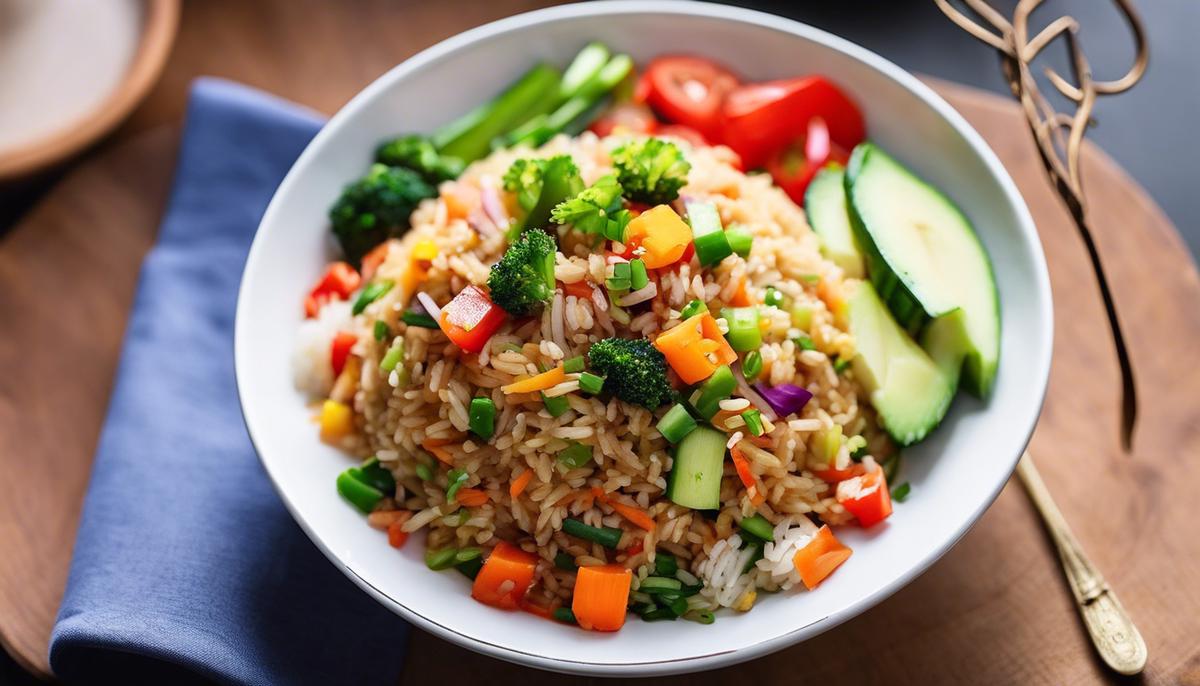In the wide spectrum of global cuisine, Chinese fried rice holds a singular allure and to master this exquisite dish is truly an intriguing affair. This tale of culinary delight nestles within the simple yet potent ingredients, the intricate stir-frying technique, and the sophistication in its presentation and serving. Delving into the art and technique of making Chinese fried rice is not merely about cooking a meal; it’s embracing the ethos of a rich and ancient culture that has perfected the science of gastronomy.
Preparation of Ingredients
Unlocking the Flavorful Secrets of Authentic Chinese Fried Rice
Chinese fried rice, a beloved and versatile dish, has traveled far and wide from its origins, delighting countless taste buds across the globe. A symphony of flavors and textures, fried rice serves as a welcoming canvas for culinary creativity, adapting effortlessly to the cook’s whims and the contents of the fridge. Yet, understanding the backbone of this dish is crucial to achieving the authentic taste. For food enthusiasts who fancy an adventurous spin in the kitchen, let’s delve straight into the ingredients and elaborate on their preparation for making the quintessential Chinese fried rice.
Rice is the heart of this dish, not just any rice, but preferably Jasmine, which gives a delicate aroma. Also, being a day or two old offers a drier texture perfect for frying. Indeed, the secret lies in how the rice is cooked, lightly seasoned with salt, and left to cool, which helps to achieve the delectable ‘separate grain’ texture.
Moving on to proteins, traditional recipes often feature small shrimp, diced ham, or cooked chicken. To keep proteins tender and juicy, consider marinating them in a simple blend of soy sauce, sesame oil, and cornstarch. If vegetarian delights are more your speed, tofu or tempeh makes a great protein substitute.
Vegetables should never be an afterthought! They add color, flavor, and healthfulness. Frequently used vegetables in Chinese fried rice include peas, corn, onions, bell peppers, carrots, or green onions. Make sure all are finely chopped or diced for a quick and even cooking process.
The flavorful stars in the humble fried rice are the seasonings. A basic trifecta of soy sauce, oyster sauce, and sesame oil provides a splendid depth of flavor. For an extra kick, consider white or black pepper. Remember, the magic lies in balancing the flavors, so don’t be heavy-handed with these additions.
While not required, eggs are usually an integral part of Chinese fried rice. Scramble eggs separately before introducing them to the pan with other ingredients, preventing them from creating a clumpy texture.
Lasty, a note on the ‘workhorse’ of Chinese cuisine, the wok. Its capacious and symmetrical shape makes it ideal for stir-frying, ensuring all ingredients are evenly cooked. However, if a wok is unavailable, a large non-stick pan can fill in.
To sum it up, Chinese fried rice is an art in balancing textures and flavors. Armed with these tips, adventurous chefs can create their own signature variation. Regardless of the ingredients you choose, remember to cook everything with passion and serve it with love. After all, that’s the essence of every great dish!

Cooking and Stir-Frying Technique
Master the Method: The Perfect Stir-Fry
Stir-frying, the heart of many treasured Chinese dishes, is an art form. It is more than just tossing assorted ingredients into a hot wok; it is a calculated dance that marries elements to create a palate tingling harmony. In this dance, each performer has a moment in the limelight; each ingredient is given the opportunity to shine with respect to its unique flavor profile. It won’t come as a surprise to our seasoned food enthusiasts that our subject today is the fundamental method of stir-frying.
The procession starts with oil, an unsung hero that often goes unnoticed but plays a pivotal role. For an authentic flavor, Sesame oil is the way to go. But worry not! This is not set in stone. There is ample room for improvisation – Peanut or Canola oil are worthy alternatives. Remember, the oil should sizzle, not smoke. The heat should be high yet manageable.
Once your oil is heated and ready, protein takes the center stage. Your marinated delicacies should be stir-fried until they are about 80% cooked, as they will continue to cook even when they are no longer the center of attention. In a true orchestrated manner, remove your semi-cooked proteins and set them aside to make way for the next performer.
Anchoring the next phase is garlic. Few can deny the exponential flavor potential these humble cloves pack. The unmistakable aroma of chopped garlic hitting the oil signals a turn in our stir-fry symphony. Sauté until golden brown and dispense in an array of additional flavor agents, such as ginger, chili paste, or crushed pepper. Play with simplicity or complexity here; the choice is yours.
As your aromatics sizzle, shape-shifting into a potent flavor bomb, now enters our star—your rice. Break apart any clumps that stick together, ensuring every grain is covered in aromatic oil. Once fully mingled, make the grand introduction of vegetables. Remember, quick-crisp is the mantra. Vegetables should retain their crunch and vibrancy.
In the homestretch, reintroduce your partially cooked protein to its now flavor-laden rice and vegetable cohorts. To bind these diverse performers together, it is essential to have the right libation. A savoury sauce is the route to take – a combination of soy sauce and oyster sauce harmonizes the elements. A dash of white pepper and a sprinkle of sugar will elevate this blend of flavor, creating a tantalizing symphony that dances on your tongue.
And finally, meet the pièce de résistance: the egg. Gently folded into the mix, treating it carefully to preserve those soft, succulent ribbons contrasting with the punchy stir-fried ensemble.
The end game of stir-frying is striking a balance between the understated elegance of the ingredients against a backdrop of dynamic, Asian-inspired flavors, creating a harmonious symphony that surely sings on your plate, with each bite serenading your taste buds. This is the unspoken language of food, conversations crafted in a wok, connecting hearts even before the meal is served around the table. The beauty of the stir-frying technique lies in its simplicity, flexibility, and capacity for spontaneity. Master this, and you uncover endless culinary possibilities: a celebration of flavor beyond borders. Irresistibly delicious, ridiculously simple—that’s the allure of a perfectly executed stir-fry.

Presentation and Serving
Moving on to the next strides in serving Chinese fried rice that radiates sincere authenticity, it’s essential to delve into garnishings, serving and the social aspect of sharing this richly flavored culinary creation.
Take a moment to appreciate the sensory delight that is your freshly made fried rice, now it’s all about enhancing the visual appeal. Spring onions or scallions finely sliced on the diagonal add vibrant dashes of color. For an extra sparking appeal, sprinkle over a handful of sesame seeds– not too many, just enough to add a gentle crunch and a gorgeous gloss. Perhaps even some crushed peanuts for added texture!
Remember, presentation counts when serving up authentic dishes. A lot of traditional Chinese dishes are served directly from the cooking pot or wok directly to the table. You could also serve the fried rice in a large, vibrant bowl or individual plates. If you’re feeling adventurous, opt for rice bowls true to Chinese dining customs and traditions. Dining in China is a communal experience so sharing is the name of the game.
They say you eat first with your eyes, but smell plays an equally important role in the experience of any meal. The rich aroma of your fried rice should whet the appetite and set the scene for the taste explosion to follow. Having cooked and used a multitude of ingredients, the amalgamation of all those flavors allows your fried rice to capture the essence of authentic Chinese cuisine.
Chopsticks or forks? True Chinese fried rice experiences call for chopsticks! The art of using chopsticks is part of the charm of authentic dining and involves you more in the eating process. If you’re inviting friends over, why not make it fun and give a quick tutorial on how to properly use chopsticks?
Chinese meals also often combine a number of dishes served at once for everyone to share. So why not add a few side dishes to accompany the fried rice? Try some dim sum or spring rolls, or a meat dish like Kung Pao Chicken. Remember the mantra, variety is the spice of life.
In conclusion, the joy of cooking is not simply about the act itself, but the art of bringing people together through food. When you serve Chinese fried rice, it’s about so much more than rice; it’s about expressing your culinary creativity, exploring new flavors, and above all, it’s about sharing. Sharing flavors, sharing cultures, sharing pieces of oneself. Let each scoop of fried rice count! Every table filled with friends, laughter, and love. Every meal, a feast for the eyes, and a celebration for the palate. Serving up Chinese fried rice, cooked with love, can truly be an authentic experience second to none.

As each grain of rice dances in rhythm in the stir-fry, harmonizing with the burst of colors and flavors from the vegetables, meat, and sauces, it unfurls an enticing narrative of a culinary journey. Unraveling the essence of making Chinese fried rice extends beyond the confines of a kitchen. It is a dance of senses, a symphony of flavors, and a testament to the boundless creativity in every cuisine. Replete with the knowledge of preparation, the dance of stir-frying, and the artistry in presentation, one can now embark on the fulfilling voyage to create and relish their masterpiece of Chinese fried rice.
